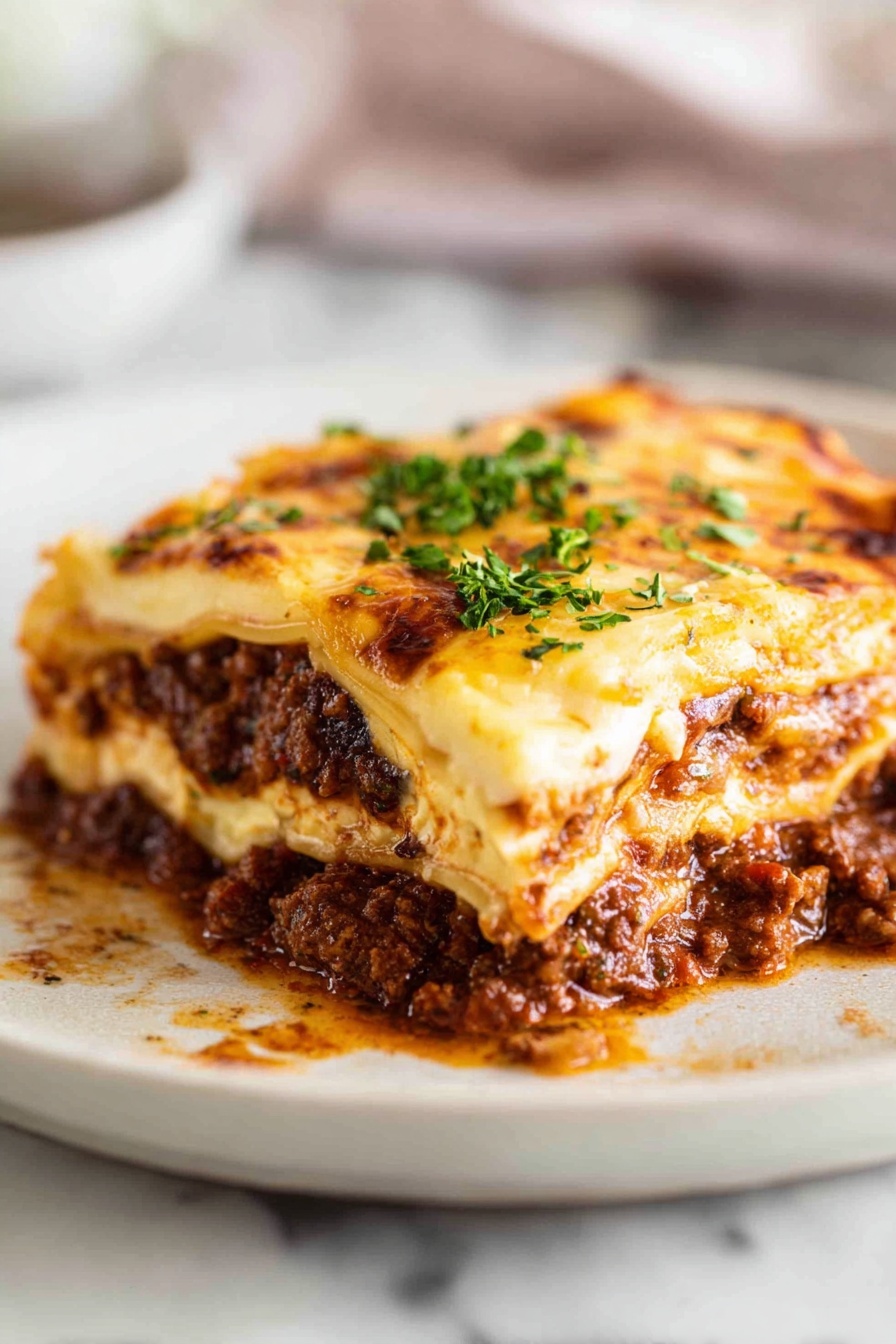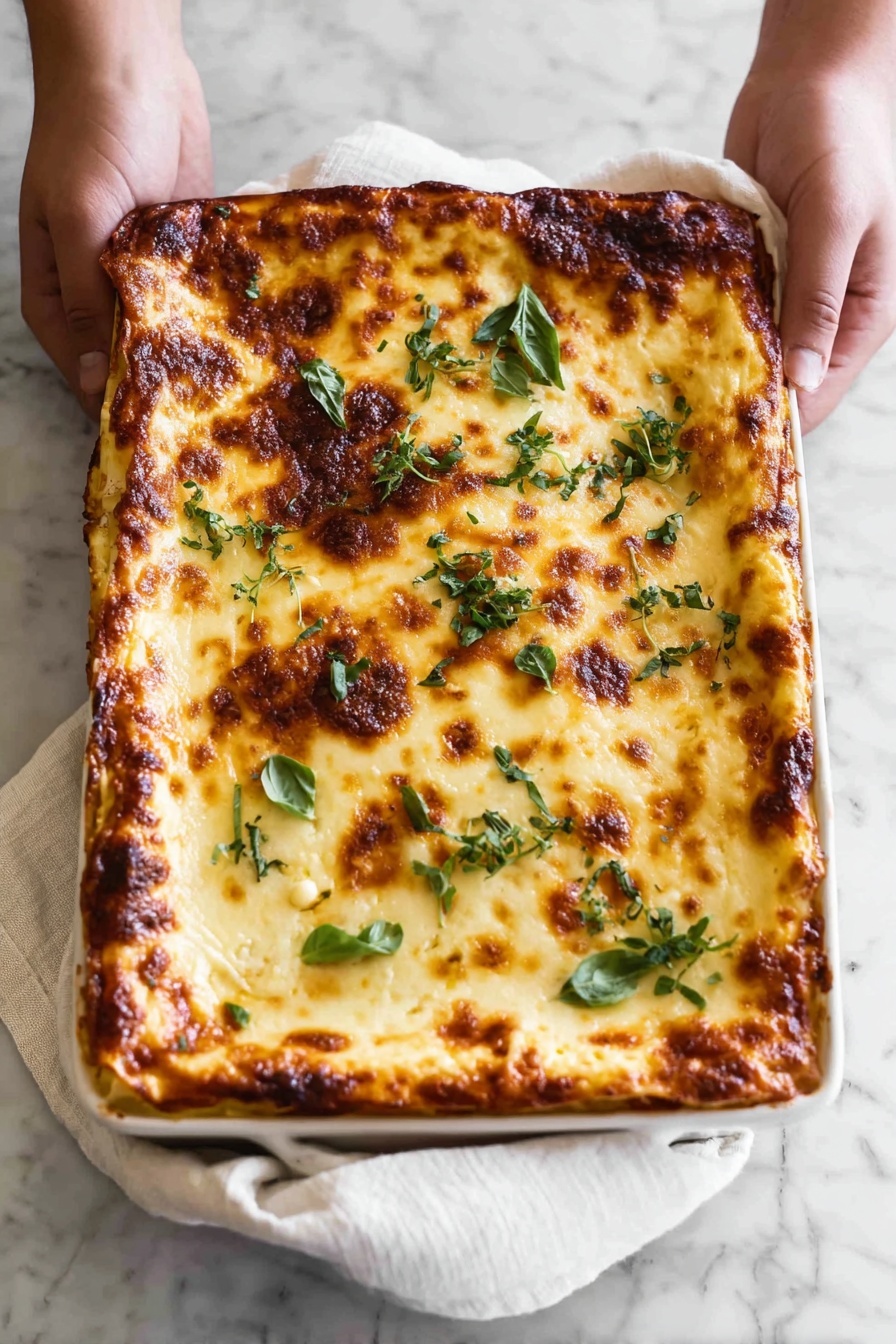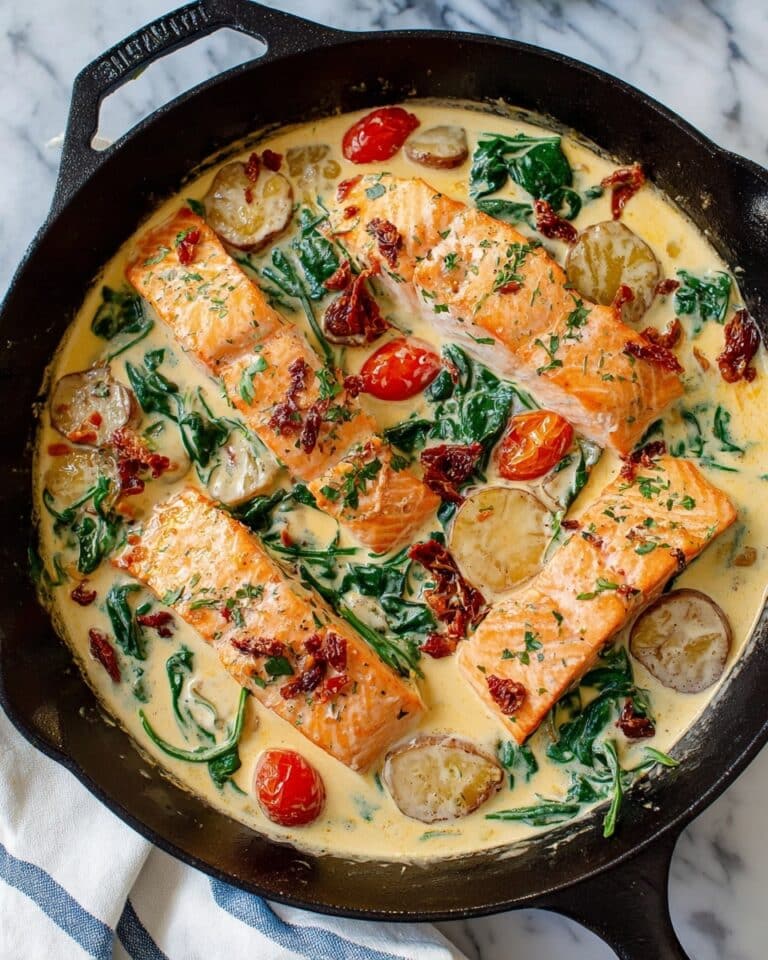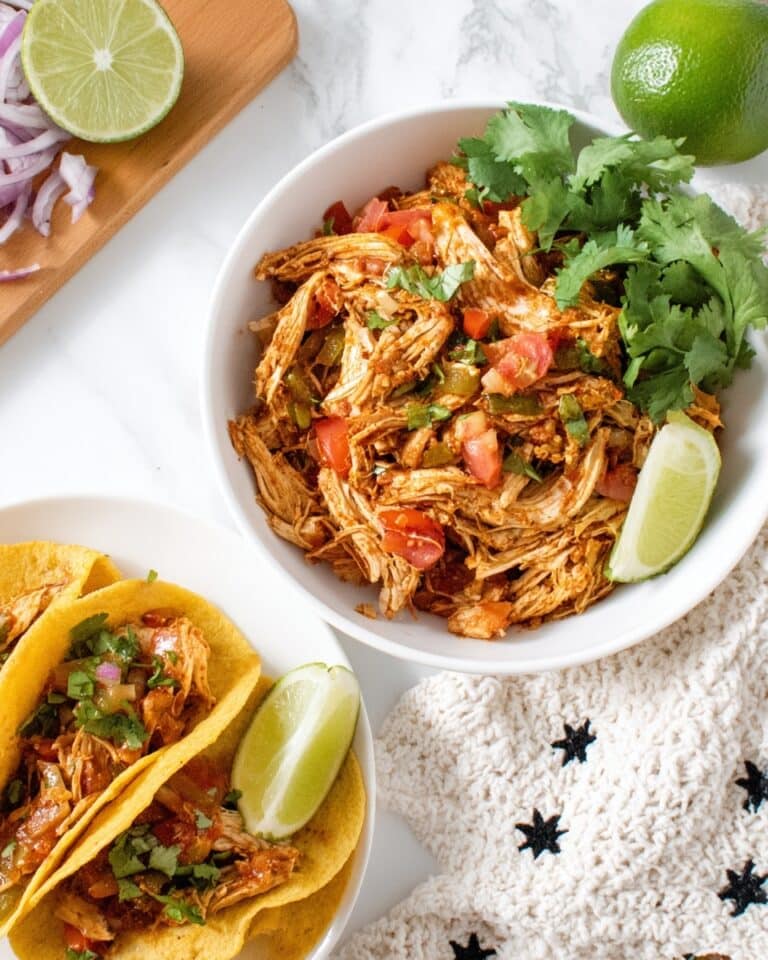If you’re looking for a rich, comforting meal that’ll wow anyone at your dinner table, you’ve got to try this Classic Italian Beef Lasagna Recipe. I absolutely love how this lasagna layers tender, slow-cooked beef ragu with a creamy béchamel sauce—no ricotta in sight, just pure old-school Italian goodness. When I first made this, I was amazed at how the flavors deepen with time, and trust me, the payoff is totally worth the patience it takes. So pull up a chair, and let me walk you through my favorite way to make this family-pleasing masterpiece!
Why You’ll Love This Recipe
- Authentic Flavors: This recipe uses traditional Italian ingredients and techniques for that melt-in-your-mouth ragu and smooth béchamel, just like Nonna used to make.
- Layered Goodness: You get plenty of cheesy, saucy layers between fresh or dried pasta sheets, making every bite satisfying and hearty.
- Make-Ahead Friendly: You can prep it in advance, and it tastes even better the next day after the flavors have married beautifully.
- Family Favorite: My loved ones go crazy for this lasagna, and it’s always the star dish at gatherings and special occasions.
Ingredients You’ll Need
Each ingredient in this Classic Italian Beef Lasagna Recipe plays a crucial role—from the aromatic veggies that form the flavor base to the richly seasoned beef and the creamy béchamel sauce that ties it all together. Using quality canned tomatoes and good cheese really amps up the taste, so don’t skimp here!
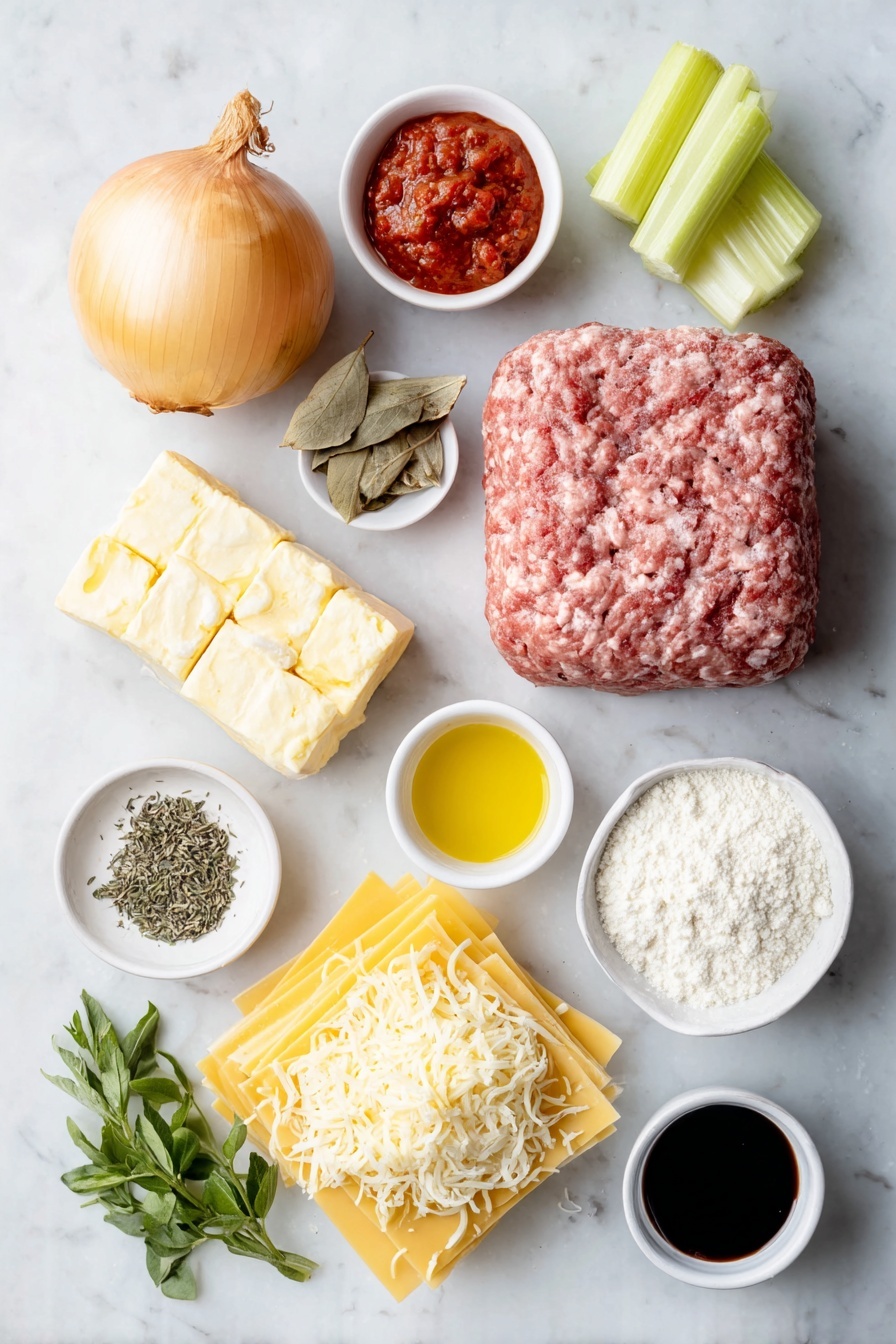
- Olive oil: Choose extra-virgin for the best flavor, it’s the foundation for sautéing your veggies.
- Onion: White, yellow, or brown all work; just make sure it’s finely chopped so it melts into the sauce.
- Carrot: Peeled and diced super small to add subtle sweetness and body to your ragu.
- Celery stick: Also finely diced, celery adds a lovely depth to the traditional soffritto base.
- Garlic cloves: Fresh and minced, garlic is essential for that classic savory punch.
- Beef mince: I always go for 80/20 lean-to-fat ratio for juicy, flavorful meat without too much grease.
- Canned crushed tomato: Look for good quality San Marzano-style tomatoes for authentic taste.
- Tomato paste: Concentrates tomato flavor and helps thicken the sauce.
- Pinot noir red wine: Or any dry red wine works—remember to cook it down well to mellow the acidity.
- Beef bouillon cubes: Crumbled to boost meaty richness in the ragu.
- Bay leaves: Either fresh or dried, they infuse subtle earthy aroma.
- Dried thyme and oregano: Classic Italian herbs that pair perfectly with the beef.
- Worcestershire sauce: Adds umami depth, a little secret to elevate your ragu.
- Sugar: Just a pinch if needed, to balance acidity—taste as you go.
- Salt and black pepper: Seasoning is key, so adjust at every step.
- Butter: The base of your béchamel for richness and smooth texture.
- Flour: Creates the roux to thicken your béchamel sauce.
- Milk: Full fat is best for creaminess, but low fat works if you prefer lighter.
- Gruyere or Colby cheese: I shred mine myself for melting magic—cheddar or Monterey Jack are fine swaps, or add parmesan for sharpness.
- Nutmeg: Just a pinch in the béchamel adds warmth without overpowering.
- Fresh lasagna sheets: I love using fresh sheets for tender layers; dried works too but needs precooking or careful timing.
- Mozzarella cheese: Freshly shredded mozzarella melts beautifully on top for that golden crust.
- Basil or parsley: Optional garnish, but a sprinkle of fresh herbs always brightens the plate.
Variations
One of the things I love about this Classic Italian Beef Lasagna Recipe is how easy it is to make your own tweaks to suit your taste or dietary needs. Don’t be afraid to experiment—the layers are forgiving and delicious whatever you try!
- Vegetarian Variation: Swap the beef with lentils and sautéed mushrooms for a hearty meat-free version my family actually can’t tell is missing meat.
- Cheese Swap: If gruyere or colby aren’t in your fridge, try sharp cheddar or a mix of mozzarella and parmesan for a slightly different but still luscious finish.
- Wine-Free Option: Just replace the wine with extra beef stock or a splash of balsamic vinegar for tang without alcohol.
- Gluten-Free: Use gluten-free lasagna sheets and substitute the flour in the béchamel with cornstarch, which I’ve done successfully when cooking for guests with allergies.
How to Make Classic Italian Beef Lasagna Recipe
Step 1: Build Your Flavor Base
Start by heating that olive oil in a heavy-bottomed pan over medium heat. Add the finely chopped onion, carrot, and celery—this trio is your soffritto, and it forms the flavor backbone of your ragu. Stir them gently until softened, about 10 minutes, and don’t rush this step! Then add the minced garlic and cook for another minute until fragrant. Trust me, taking time here pays huge dividends in flavor.
Step 2: Brown the Beef Mince
Toss in the beef mince and break it apart with your spoon or spatula. Brown it thoroughly without stirring too often—that way, you get those lovely caramelized bits that make the sauce so rich. Once browned, drain excess fat if needed but keep enough to carry the flavor.
Step 3: Simmer the Ragu
Next, add crushed tomatoes, tomato paste, red wine, crumbled beef bouillon cubes, bay leaves, thyme, oregano, Worcestershire sauce, salt, and pepper. Bring it to a gentle simmer, then reduce the heat to low. Let this baby cook slowly for around 3 to 4 hours, stirring occasionally. You’ll notice it thickening and developing an incredible depth of flavor. If it seems too acidic, sprinkle in a teaspoon or two of sugar—this trick totally balances the sauce.
Step 4: Make the Béchamel Sauce
While the ragu simmers, melt the butter in a saucepan over medium heat. Whisk in the flour and cook for a couple minutes until it’s bubbling but not browned—that’s your roux. Slowly pour in the milk while whisking constantly to avoid lumps. Keep whisking until the sauce thickens to a creamy consistency. Stir in shredded gruyere (or cheese of choice), nutmeg, salt, and pepper. This sauce should be luscious and smooth.
Step 5: Assemble the Lasagna
In a deep baking dish, spread a thin layer of béchamel sauce on the bottom to prevent sticking. Then lay down a layer of lasagna sheets (fresh or dried). Top with a scoop of ragu, then béchamel, and a sprinkle of mozzarella. Repeat layering 3 to 4 times, finishing with a generous topping of béchamel and mozzarella for that golden crust.
Step 6: Bake and Rest
Bake your assembled lasagna in a preheated oven at 180°C (350°F) for about 45 minutes until bubbly and golden on top. Here’s what I learned: let it rest for at least 20 minutes before slicing—this helps it set nicely so your portions hold together perfectly.
Pro Tips for Making Classic Italian Beef Lasagna Recipe
- Slow Simmering: Don’t rush the ragu—slow cooking builds layers of flavor and tenderizes the beef wonderfully.
- Fresh Cheese Magic: Shredding your own cheese melts better and gives a fresher taste compared to pre-shredded bags.
- Béchamel Consistency: Whisk continuously when making béchamel to avoid lumps and achieve that silky texture.
- Rest Before Serving: Let the lasagna rest after baking so it slices cleanly and the layers stay intact.
How to Serve Classic Italian Beef Lasagna Recipe
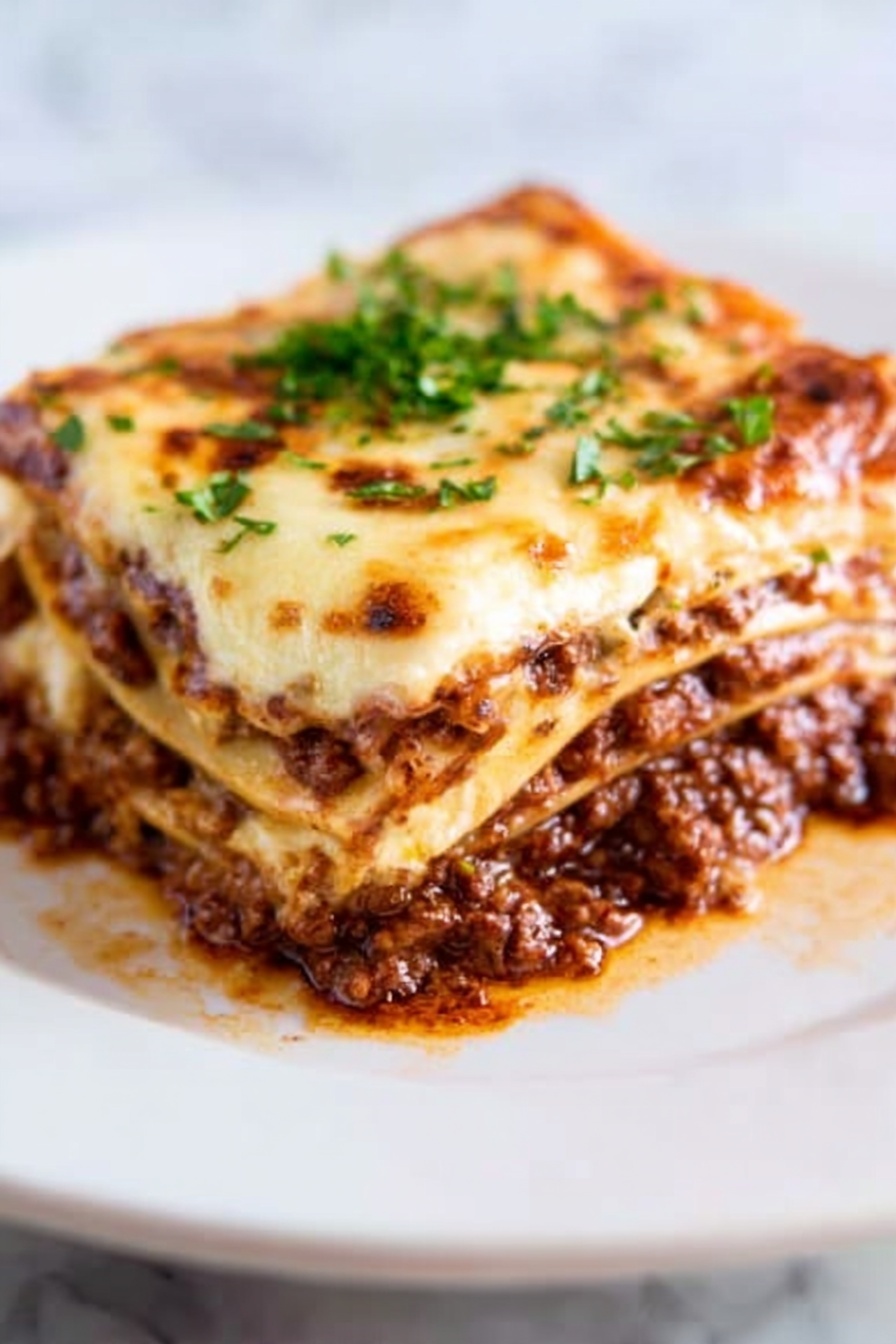
Garnishes
I love a simple sprinkle of finely chopped fresh basil or parsley just before serving—it adds a burst of color and freshness that cuts through the rich layers perfectly.
Side Dishes
Classic Italian sides for me are a crisp green salad with lemon vinaigrette or some garlicky sautéed broccoli rabe. If I want to go all out, I serve it with warm garlic bread to sop up every last bit of that gorgeous sauce.
Creative Ways to Present
For special occasions, I sometimes serve mini individual portions in ramekins with a sprinkle of extra cheese on top, broiled until golden and bubbly—it’s a fun, elegant twist that guests adore.
Make Ahead and Storage
Storing Leftovers
Leftover lasagna stores beautifully in the fridge for up to 3 days. I keep portions tightly wrapped or in airtight containers to preserve moisture and avoid drying out.
Freezing
If you want to prep in advance, this Classic Italian Beef Lasagna Recipe freezes wonderfully. I recommend freezing it fully assembled before baking—just wrap tightly in foil and plastic wrap. When ready, thaw overnight in the fridge and bake as usual.
Reheating
To reheat, pop leftovers in a 180°C (350°F) oven covered with foil to keep moisture in, about 20 minutes or until heated through. Avoid the microwave if you can—you’ll lose that lovely texture in the béchamel and pasta layers.
FAQs
-
Can I use dried lasagna sheets in this Classic Italian Beef Lasagna Recipe?
Absolutely! If you use dried sheets, many brands require pre-boiling before layering, but some are “no-boil” types. If using no-boil, make sure your ragu and béchamel are a bit saucier to allow the pasta to cook perfectly in the oven.
-
Why is there no ricotta cheese in this recipe?
This Classic Italian Beef Lasagna Recipe follows traditional Italian techniques where béchamel sauce replaces ricotta, which is more common in American-Italian versions. The béchamel adds a silky texture and rich flavor that balances the beef ragu beautifully.
-
How long can I make the ragu in advance?
You can make the ragu up to 2 days ahead and refrigerate it. In fact, it tastes even better after resting as the flavors meld. Just reheat gently before assembling your lasagna.
-
Can I freeze leftovers after baking?
Yes! Once cooled, slice the lasagna and wrap individual portions tightly before freezing. This way, you can reheat just what you want without wasting any.
Final Thoughts
This Classic Italian Beef Lasagna Recipe has been a labor of love for me, and it’s become the ultimate comfort food in my kitchen. I remember the first time I made it from scratch—it took time, but every spoonful was worth the wait. If you follow the steps and take your time simmering that ragu and perfecting the béchamel, you’ll end up with a lasagna that feels like a warm hug on a plate. Trust me, your family and friends will rave about it, and you’ll want to make it again and again. Go on, give it a try—you’ll be so glad you did!
Print
Classic Italian Beef Lasagna Recipe
- Prep Time: 20 min
- Cook Time: 240 min
- Total Time: 260 min
- Yield: 10 servings
- Category: Main Course
- Method: Baking
- Cuisine: Italian
Description
This traditional Italian lasagna recipe features a slow-cooked beef ragu and a creamy béchamel sauce, layered between fresh or dried lasagna sheets, and topped with melted mozzarella and gruyere cheese. Unlike the American version, it uses no ricotta, providing a rich, melt-in-your-mouth texture with deeply layered flavors. Perfect for a hearty family meal, this lasagna serves 10 and requires some patience but rewards with every bite.
Ingredients
Ragu
- 1 tbsp olive oil
- 1 onion, finely chopped (white, yellow or brown)
- 1 medium carrot, peeled and very finely diced
- 1 celery stick, very finely diced
- 2 garlic cloves, minced
- 1 kg / 2 lb beef mince (ground beef)
- 800g / 28 oz canned crushed tomato
- 1/4 cup tomato paste
- 1 cup pinot noir red wine (or other dry red wine)
- 3 beef bouillon cubes, crumbled
- 2 bay leaves, dried or fresh
- 1/2 tsp each dried thyme and oregano
- 2 tsp Worcestershire Sauce
- 1 – 2 tsp sugar (if needed)
- 1/2 tsp salt and black pepper
Béchamel Sauce
- 60g / 4 tbsp butter
- 1/2 cup flour
- 4 cups milk (preferably full fat but low fat ok)
- Pinch of freshly ground nutmeg
- Salt and pepper to taste
Cheese and Pasta
- 2 cups gruyere or Colby cheese, shredded (or cheddar, Monterey Jack, OR 1 cup / 100g shredded parmesan)
- 350g / 12 oz fresh lasagna sheets (or 250g / 8 oz dried)
- 1 1/2 cups tightly packed mozzarella cheese, shredded
- Finely chopped basil or parsley for garnish (optional)
Instructions
- Prepare the ragu: Heat olive oil in a large pan over medium heat. Add finely chopped onion, carrot, celery, and garlic, cooking gently until softened without browning. Add the beef mince and cook until browned, breaking up any lumps.
- Add liquids and seasonings: Stir in canned crushed tomato, tomato paste, red wine, crumbled beef bouillon cubes, bay leaves, thyme, oregano, Worcestershire sauce, sugar (if using), salt, and pepper. Bring to a simmer.
- Slow cook the ragu: Reduce heat to very low, cover partially, and let the ragu cook gently for about 4 hours, stirring occasionally to prevent sticking and ensuring a rich and thick consistency. Adjust seasoning as needed.
- Make the béchamel sauce: In a separate saucepan, melt butter over medium heat. Whisk in flour to make a roux and cook for 1–2 minutes without browning. Gradually add milk, whisking constantly until the sauce thickens and is smooth. Add nutmeg, and season with salt and pepper to taste. Remove from heat.
- Preheat the oven: Heat oven to 180°C (350°F) to prepare for baking the assembled lasagna.
- Assemble the lasagna: In a large baking dish, spread a thin layer of ragu at the bottom. Place a layer of lasagna sheets over the sauce. Spread a layer of béchamel sauce, then sprinkle with a mix of gruyere (or your chosen cheese). Repeat layers—lasagna sheets, ragu, béchamel, cheese—3 to 4 times, ending with a béchamel and a generous topping of shredded mozzarella cheese.
- Bake the lasagna: Cover the baking dish loosely with foil and bake in the preheated oven for about 40 minutes. Remove foil and bake for another 10–15 minutes until top is golden and bubbly.
- Rest and serve: Let the lasagna rest for 10–15 minutes before slicing to allow it to set. Garnish with chopped basil or parsley if desired, then serve.
Notes
- Recipe video available above for guidance.
- One of the author’s signature recipes, made the traditional Italian way with slow-cooked ragu and béchamel sauce; no ricotta used.
- The ragu requires patience to develop tender, rich flavors, but the result is worth every minute.
- This recipe yields 8 giant or 10 normal servings and features 4 layers of lasagna sheets with 3 layers of meat and cheese sauce, finished with cheese topping.
- To make 5 layers, increase the recipe by 25% and use a very deep pan.
- Fresh lasagna sheets work best but dried can be used as a substitute.
- Adjust sugar in ragu if the tomato sauce is too acidic.
- You can substitute cheeses based on preference, but gruyere and mozzarella provide traditional flavor profiles.
Nutrition
- Serving Size: 398 g
- Calories: 594 kcal
- Sugar: 11 g
- Sodium: 979 mg
- Fat: 29 g
- Saturated Fat: 15 g
- Unsaturated Fat: 12 g
- Trans Fat: 1 g
- Carbohydrates: 40 g
- Fiber: 2 g
- Protein: 39 g
- Cholesterol: 146 mg

